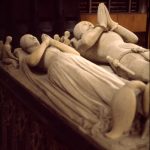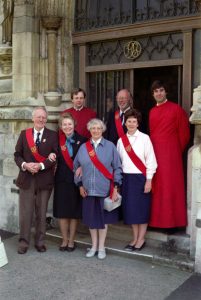The second novel in my Lady Apollonia West Country Mysteries is a prequel, Plague of a Green Man, set in Exeter, Devon, in 1380, twenty years earlier than my first novel. I selected Exeter because it is the city which enabled me to experience firsthand a living survivor of medieval England.
In four different years between 1988 and 1998, I lived in Exeter with my husband, Lou, who was a Visiting Professor in the Computer Science Department at the University of Exeter. Each time we lived in a different part of the city but always close enough to its center that I could walk to the 14th century medieval cathedral built in the English Decorated Gothic style.
Although I had no direct connection with the University of Exeter, I was intensely interested in the ancient city’s history going all the way back to Roman times. The modern city center is enclosed by remains of a medieval wall that has the same footprint as its Roman wall and displays its Roman origins in places. Though badly bombed during World War II, there are still many buildings and ruins in Exeter from the medieval period, and I wanted to explore these, frequently with my husband in his spare time.
As a history major in college, Exeter Cathedral was of particular interest to me, so I went there one day shortly after our arrival, when Lou was at work; I was greeted by one of the Cathedral Stewards, volunteers who welcome visitors. I asked if there was anything that I could do as a volunteer and was told that I could serve as one of them, and that is how I became a regular Monday Steward. A picture of a younger me with the Monday Stewards is shown above.
In addition to becoming a regular Steward, I read extensively about the cathedral’s history and designed an hour-long tour to use as a volunteer guide who leads visitors around the cathedral, helping them to connect with various aspects of the ancient building. My husband, Lou, tells me that the beginning of the tour of Exeter Cathedral which my heroine, Lady Apollonia, is given in my medieval novel reminds him of how I always started my guided tours when I was given the opportunity some 600 years later.
 The Englishman Ken Maun, who led the Monday stewards and became my good friend, took me under his wing and tutelage and shared his insights with me; it was a wonderful chance to learn more about this magnificent building. I was given hands-on experience of a 14th century building that would never have been possible in my home country of America. Even more than the building itself, the cathedral held monuments from the medieval period that revealed much about important people of the period, including how they dressed. The Courtenay tomb in the south transept is shown on the left. It displays two carved stone effigies of an earl and his duchess: husband and wife. They were historic Devon aristocrats and are shown wearing clothes, head to toe, which were fashionable in 14th century Exeter.
The Englishman Ken Maun, who led the Monday stewards and became my good friend, took me under his wing and tutelage and shared his insights with me; it was a wonderful chance to learn more about this magnificent building. I was given hands-on experience of a 14th century building that would never have been possible in my home country of America. Even more than the building itself, the cathedral held monuments from the medieval period that revealed much about important people of the period, including how they dressed. The Courtenay tomb in the south transept is shown on the left. It displays two carved stone effigies of an earl and his duchess: husband and wife. They were historic Devon aristocrats and are shown wearing clothes, head to toe, which were fashionable in 14th century Exeter.
My extraordinary experiences as a steward and tour guide at Exeter Cathedral inspired me to set Plague of a Green Man in 14th century Exeter. The cathedral plays a role in my story, as will other medieval features of Exeter, which I look forward to discussing in my next post.
